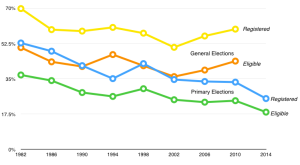Probably the most frequent question I am getting right now is what my estimates of turnout will be. Of course, people just want me to repeat my idiocy from June, in which I projected a pessimistic 33.5% turnout. Of course, the fine voters of the Golden State one-upped me, and only 25.17% of registered voters turned out, fifteen points lower than the average of the previous 8 elections. So, yeah, I’m not exactly enthused about predicting the enthusiasm of a very politically unenthusiastic electorate.
Nevertheless, providing uninformed opinions is what The Nooner is always about, right?
Let’s look at a pretty picture of turnout for primary and general elections since Jerry Brown last left the corner office:
 As you can see, turnout has been on a steady decline in both primary and general elections. Each is on a downward trend, although primary participation is declining faster than that in general elections.
As you can see, turnout has been on a steady decline in both primary and general elections. Each is on a downward trend, although primary participation is declining faster than that in general elections.
The highest turnout in a gubernatorial election during this period was in 1982, when 52.7% of voters cast ballots in the primary and 69.8% voted in the general. That was the close race that saw George Deukmejian edge Tom Bradley (D). The low was 2002, when Gray Davis was on the ballot for reelection. That election was also held in March, as part of the legislative experiment to provide California more influence in primaries in presidential years.
One way to project turnout for a general election is to look at the general-to-primary ratio. This recognizes that interest in an election cycle generally trends together. Whether it be candidates or overall political climate, voters get stirred up for the primary and carry that electoral interest to the general election.
The average general:primary ratio during the previous eight gubernatorial elections is 1.49. If we apply that to 2014–applying the multiplier to the primary turnout–it would suggest an abysmal 39.27% turnout of registered voters in November. This would be 20 points below the average during the 32-year period at which we are looking.
However, I believe turnout will be higher, and I believe the top-two primary is partially to blame. In June, Democratic and Democratic-leaning voters knew that Jerry Brown was going to be the nominee. In some areas, however, I would proffer that the quantity of choices led some voters to throw up their hands in confusion.
While proponents of top-two argued that it would increase turnout by involving independent voters in primaries, there may be a backfire in that the menu was just too damn long. It’s how I feel when I go to have breakfast at Denny’s. Just give me a few choices. I hypothesize that the less partisan voters often are okay to defer to others to narrow a broad field but then may play in the general. Anyway, this is the first gubernatorial election under top-two and we simply don’t have enough data points to make a conclusion.
Some may suggest that SB 202, the bill that moved nearly all ballot measures to general elections is also to blame. That may be the case in some years, although I don’t believe it for 2014. Outside of our little bubble, no voter will make a decision on whether to vote or not based on the mix of measures on the ballot. Aside from the water bond, the measures are super complex policy choices that don’t drive passion at all. None are like the big social issues that stir up occasional, particularly young, voters. If you don’t believe me, I challenge you to pick up the phone and try to explain the ballot measures to mom.
So, we start with a baseline of 39.27%, and then the question becomes whether other voters are stirred up enough to turn out. My bet is in the mid-40% range, which would set a record of a low for a gubernatorial election.
Is there a partisan impact of super-low turnout? That’s unlikely, as I believe the bar rises and falls equally in an election like this. Sure, it could affect some of the toss-up legislative races, but it’s unlikely to significantly affect the top of the statewides.
Originally published in the Nooner.

